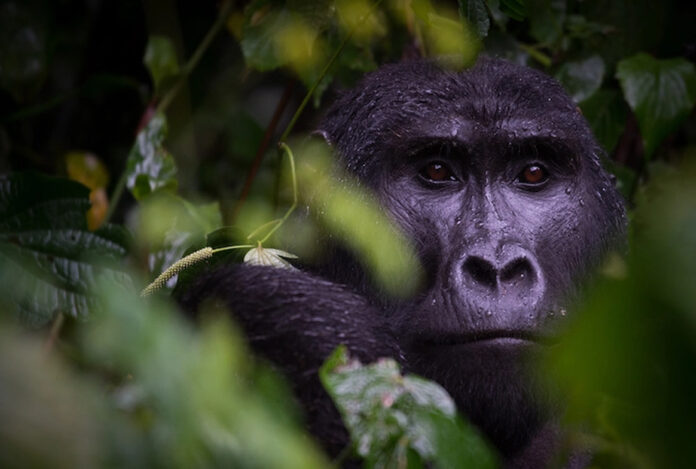Tracking for gorillas is an unforgettable wildlife experience, one you should attempt at least once in your lifetime. The thrill and exhilaration of seeing these majestic creatures in their natural habitat is really a privilege, leaving you with magical memories that last a lifetime.
Mountain gorillas can be seen in Rwanda, at the Volcanoes National Park, and in Uganda, both at Bwindi National Park and Mgahinga National Park, though Mgahinga has inconsistent sightings as the gorilla groups tend to move around, either moving to the Democratic Republic of Congo, or Rwanda.
So how do you choose where to go? Which one will suit your particular requirements? Rwanda or Uganda? Let us examine gorilla tracking in both areas.
Rwanda
The biggest advantage here is the distance to the park from Kigali airport – it is a 2-3 hour drive on tarmac roads so one can easily drive to the Volcanoes National Park Rwanda, do the trek and drive back to the airport, all in one day. However, it is recommended to spend at least one night at a lodge near or in the park, and do the trek the next day when you are fresh and rested, making it a two day visit at the very minimum. There are many lodging options available, though most are on the higher end of the spectrum.
The cost of the permit doesn’t come cheap, US$1500 per person, and although more permits are issued as Rwanda has twice the number of habituated mountain gorillas as Uganda, the permits are sold quicker, so one needs to book well in advance. Taking into account the higher fee for the permit, together with the costlier lodging options, one may feel that the total cost for the Rwanda gorilla safari experience will be much higher, however this is compensated for by the less expensive vehicle costs for shorter transfer to the park and back, and also by the fact that one only needs to spend a night or two at the lodge.
Permits are allocated based on the age, health and fitness level of the trekker, as well as on other interests. The allocation of groups is done after the briefing, and those who are stronger and more adventurous are allotted to hard families, while those that are elderly, weaker or less physically fit are allotted to groups that are close by and easier to trek to.
There are more chances that you will have shorter distances to hike to see the gorillas in Rwanda, but there are no guarantees as one may have to trek further sometimes, but of course it is worth it!
The gorilla groups in Rwanda are the most wholly habituated and are found in bamboo rather than dense forest, making photography much easier.
The trekking experience is more charming here, with tea/coffee being served before the trek while you are entertained by a traditional dance troupe.
Although you can also trek for golden monkeys here, there is no ‘big five’ wildlife experience available, so if you are looking to do a longer safari, you may need to combine Rwanda with either Kenya or Tanzania.
Uganda
One of the biggest drawbacks here is the travel time from either Entebbe airport or Kampala to the Bwindi Impenetrable Forest – the distance is 500km and takes about 8 hours to drive. Most people opt to do this in two days, breaking their journey at Lake Mburo National Park. Thus the minimum number of days needed here is three – one to drive there, one for the trek and the third day to drive back. Flights to Bwindi are now available, although the flights are on the pricey side.
Although the drive is long, it is an enchanting drive, offering visitors intimate views of rural Africa and beautiful terraced mountains with flowing rivers, perfect for the tourist wishing to see more of the people and culture of the country.
The permits are much cheaper at US$800 per person and they even go down to US$500 per person during the low season. The permits are allocated on a first come first serve basis and they do not take into account the age or fitness level of the trekker. However, taking into consideration the long journey to Bwindi, the fact that you have to spend two nights at the lodge and the return journey, the costs, despite the lower fees for the Bwindi gorilla permit, may work out to be the same or even more than for Rwanda.
The terrain at Bwindi is more mountainous and the jungle is quite thick (hence the name Impenetrable), so the trek can be more arduous and physically taxing.
The Bwindi Impenetrable National Park is stunningly beautiful, however there may be less visibility due to the tall grass, and so less photographic opportunities.
Uganda has more to offer than only gorillas, it has the best chimpanzee tracking in all of Africa, as well as other wildlife areas like Queen Elizabeth National Park and Lake Mburo National Park, in addition to areas of natural beauty like Murchison Falls, so one can combine all these for a longer trip.
The takeaway from this is that, Rwanda is a good choice if one wants to make a quick gorilla safari and also for those who are apprehensive about the physical trekking itself. For those who are more adventurous, and for those looking for a longer stay, maybe combining gorilla tracking with chimp tracking, or culture, walking, game viewing etc, then Uganda is the best choice.
A lot of visitors opt to do both – they start out with a visit to the Volcanoes National Park in Rwanda, then drive from here to Bwindi Impenetrable Forest (nearer to Rwanda than Kampala or Entebbe), and do the second trek here.
Wherever you track for gorillas, rest assured that the hour you spend with them, will be one of the most magical moments of your life and will live in your memories forever.




















